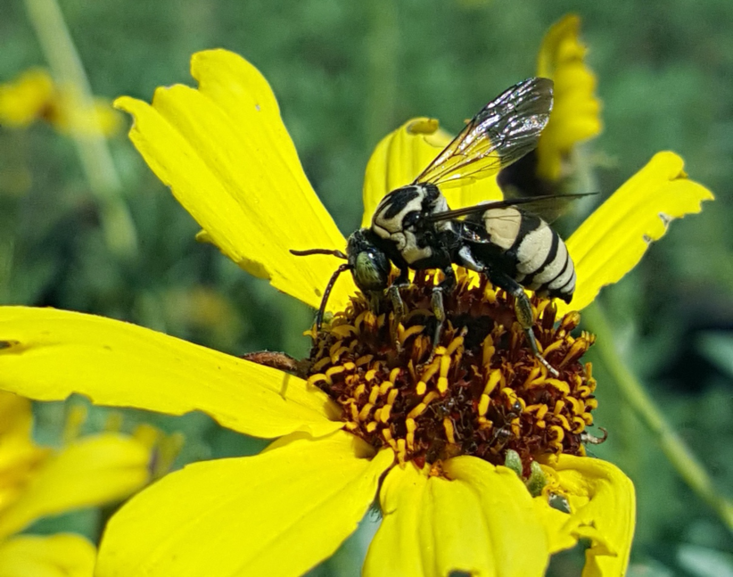
The bees that cheated the system — and what we can learn from them
When I share with people that there are over 1,600 species of bees in California and over 20,000 worldwide (that is more than the number of mammal, bird, and reptile species combined), I am often met with shock. I usually go on to describe the great diversity of sizes, shapes, colors, and behaviors exhibited by these diverse creatures and how most differ substantially in these aspects from the familiar honey bee, Apis mellifera. Part of my PhD research involves surveying bee communities in agricultural areas around southern California, so I have come face-to-face with many of these astounding insects. If I still have the other person’s attention at this point in the conversation, I relish in talking about a group of bees that break all the rules you would think bees follow. I am referring to the cuckoo bees.
Cuckoo bees did not get their name because they are mad or crazy (though if you were to ask a non-cuckoo bee, they may have a different opinion). Rather, the namesakes of these bee species are cuckoo birds, whose infamous and unorthodox nesting behavior has intrigued humans for centuries. Cuckoos are brood parasites, meaning they raise their young by exploiting other species of birds. A cuckoo will physically lay its eggs inside the nest of another bird species, referred to as the host. Clever strategies have evolved to facilitate this presumably risky tactic, such as the cuckoo’s eggs mimicking those of its host. Obviously, parasitism benefits the cuckoo because it shifts a lot of work onto their unwitting host. The cuckoo gets to focus on producing even more eggs (and, perhaps, pursuing new hobbies) without the annoyances of guarding a nest, incubating said eggs, raising their young, and all the other hallmark joys of parenting. Sounds like a pretty profitable scheme, right? But enough about birds.
Somewhere along the way, some bees must have picked up on this game plan. Cuckoo bees, also referred to as cleptoparasitic bees (from the Greek word kleptēs meaning “thief”), forego collecting pollen (bees’ main protein source) for their offspring like most bees do. Instead, they have adopted the approach of furtively laying their eggs inside other bees’ nests. Some cuckoo bees are very specific in the species of bees they parasitize, while others are less picky. Inside the host’s nest, the adult cuckoo bee or its newly hatched larva will kill the host larva, allowing the cuckoo larva to consume the pollen left by the host mother bee. At the end of the day, cleptoparasitism reduces the host bee’s reproductive output. Since cuckoo bee reproduction depends on the pollen collected by their hosts, cuckoo bees lack the bushy body hairs we associate with most other bees. Instead, the hairs are extremely sparse or closely pressed to the body, giving them a wasp-like appearance (see photo below).
Despite their seemingly malevolent nature, the presence of cuckoo species in a community is, paradoxically, a good thing. Just as with birds, cleptoparasitic bees can serve as bioindicators of a thriving and diverse ecosystem. Think about it: if the cuckoo’s host is not present or abundant enough, the cuckoo will struggle to reproduce and eventually disappear. Disturbances affecting host species (such as pesticides, habitat loss, and disease) may first be detected by declines and disappearances of cuckoo species. In short, the persistence of cleptoparasites is symbolic of a thriving community, while their absence could be a harbinger of ecosystem instability.
In my research, I have found several species of cleptoparasites while surveying for bee species in agricultural areas. Despite the fact these places are intensively managed and artificial by design, the presence of cleptoparasites is a reassurance that their hosts are doing fine, at least for the time being. I think we can all stand to learn something from cuckoo bees. Not that exploiting others for our personal gain is a successful strategy—that was certainly not the point of this article. Rather, the next time you see an insect you may think of as insidious, take a moment and ponder if, like a cuckoo bee, its very existence could actually represent an invaluable lesson about some aspect of our natural world.
References and further reading
Morelli, F., Møller, A. P., Nelson, E., Benedetti, Y., Liang, W., Šímová, P., ... & Tryjanowski, P. (2017). The common cuckoo is an effective indicator of high bird species richness in Asia and Europe. Scientific Reports, 7(1), 1-8.
Lahti, D. C. (2005). Evolution of bird eggs in the absence of cuckoo parasitism. Proceedings of the National Academy of Sciences, 102(50), 18057-18062.
Croston, R. & Hauber, M. E. (2010) The Ecology of Avian Brood Parasitism. Nature Education Knowledge 3(10):56. https://www.nature.com/scitable/knowledge/library/the-ecology-of-avian-brood-parasitism-14724491/
Thorp, R. W. (2000). The collection of pollen by bees. Plant Systematics and Evolution, 222(1), 211-223.
Sheffield, C. S., Pindar, A., Packer, L., & Kevan, P. G. (2013). The potential of cleptoparasitic bees as indicator taxa for assessing bee communities. Apidologie, 44(5), 501-510.
###
About SciComm@UCR: SciComm@UCR is a student organization working to communicate science in creative ways and bring science communication training to our University of California, Riverside community. SciComm@UCR was established in 2019, when the organization organized the Let's Talk Science communications workshop. SciComm@UCR is currently producing the second season of their new podcast, Beyond the Bench, and organizing local science outreach events. Learn more about SciComm@UCR at scicomm.ucr.edu.
READ THE ORIGINAL BLOG POST A SCICOMM@UCR

